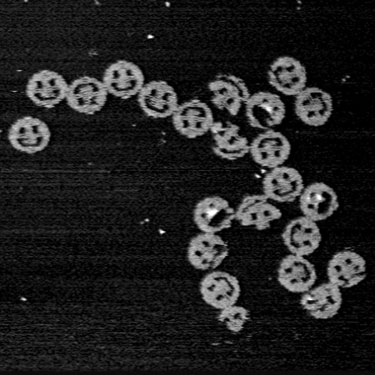History of the Smile Face

Paul W.K. Rothemund, Caltech, 2006. Full caption below*
The Smile Face has played a defining role in visual culture since its inception as an icon in the mid 20th century.
Stylized images of a happy face have been found in archaeological sites dating back thousands of years in locations ranging
from caves in France to Pueblo Indian cliff carvings in New Mexico.
Modern references to the Smile Face date from a cartoon image of a laughing face in a 1953 movie poster for Lili.
A promotional campaign for a radio station in New York employed a stylized smiling face on a yellow sweatshirt
in 1962 with the tag line "WMCA Good Guy."
The first credited use of a smiling face combined with a yellow circle is the graphic image produced by Harvey Ball in
1963 to improve morale at State Mutual Life Assurance of Worcester, Massachusetts.
The designer stated that the button had a "sunny" feel.
Another noted origin of the icon was its use in an advertising campaign created by David Stern.
He combined the image with the lyric "Put on a Happy Face" from the musical Bye, Bye, Birdie.
Stern later employed the image in his 1993 run for Seattle Mayor.
The first commercial-scale effort to promote the Smile Face icon was the work of brothers Bernard and Murray Spain of Philadelphia
in the early 1970's. They combined the image with the slogan "Have a happy day" and printed it on a variety of objects
including buttons, coffee mugs, t-shirts, and bumper stickers. The familiar greeting "Have a nice day" eventually became
associated with the Smile Face.
Several attempts have been made to trademark the icon. Frenchman Franklin Loufrani’s company Smile World, Ltd. succeeded
in registering the trademark in over a hundred countries. Wal-Mart contested Loufrani’s claim in the United States with a trademark
application of their own. This matter was resolved in a court decision in 2008 that declared that the Smile Face is not
a "distinctive" mark and cannot be owned in the United States.
The Smile Face is a ubiquitous part of mass media as well as an ambiguous personal statement. In 2002, Lucas John Helder
produced a manifesto against technology and the unhappiness he believed it caused. He placed pipe bombs in locations around
the mid-west. When plotted on a map, the explosions formed the image of a Smile Face.
The icon has been satirized and adapted endlessly. The band Nirvana incorporated a dead Smile Face into its logo, inspired
by a strip club sign in Seattle. The symbol has become so much a piece of our consciousness that we have seen it on a crater
on Mars and created it in some of our first experiments with nanotechnology.
Although the common usage of the symbol ebbs and flows, the Smile Face icon is a fundamental figure in our culture that is
unlikely to fade.
- Alec Garbini, February, 2014
* Image Caption for Paul W.K. Rothemund, Caltech, 2006:
A flock of smiley-faced DNA origami on an atomically-flat mica surface.
Each smiley is 100 nanometers wide and just 2 nanometers thick.
70 of them could fit across the width of a red blood cell, and over 1000
could fit across the width of a human hair. The image was created by
raster scanning a fine micromachined needle back and forth across the
origami over the course of about 10 minutes---a computer reconstructed
deflections of the tiny needle as an image. DNA origami are created
when about 200 different short DNA strands self-assemble and fold a
much longer DNA strand into a desired shape. The sequences for the
short strands were designed using a computer-aided design program.
Any two-dimensional or three-dimensional DNA shape can be
designed in this way. The sequences were synthesized commercially for
about $1000. Mixed together in salt water, heated to near boiling,
and cooled to room temperature, the strands form about 100 billion
smileys in a single drop of water. While the smiley faces were a fun
demonstration of the technique, DNA origami is intended for serious
purposes. Around the world scientist are using DNA origami in a variety
of nano-sized applications, from "smart containers" for drugs which open
only upon binding a particular type of cell, to tiny pegboards upon
which a variety of electronic components can be attached and connected
into a circuit.
Image courtesy of Paul W.K. Rothemund, Caltech.

|



